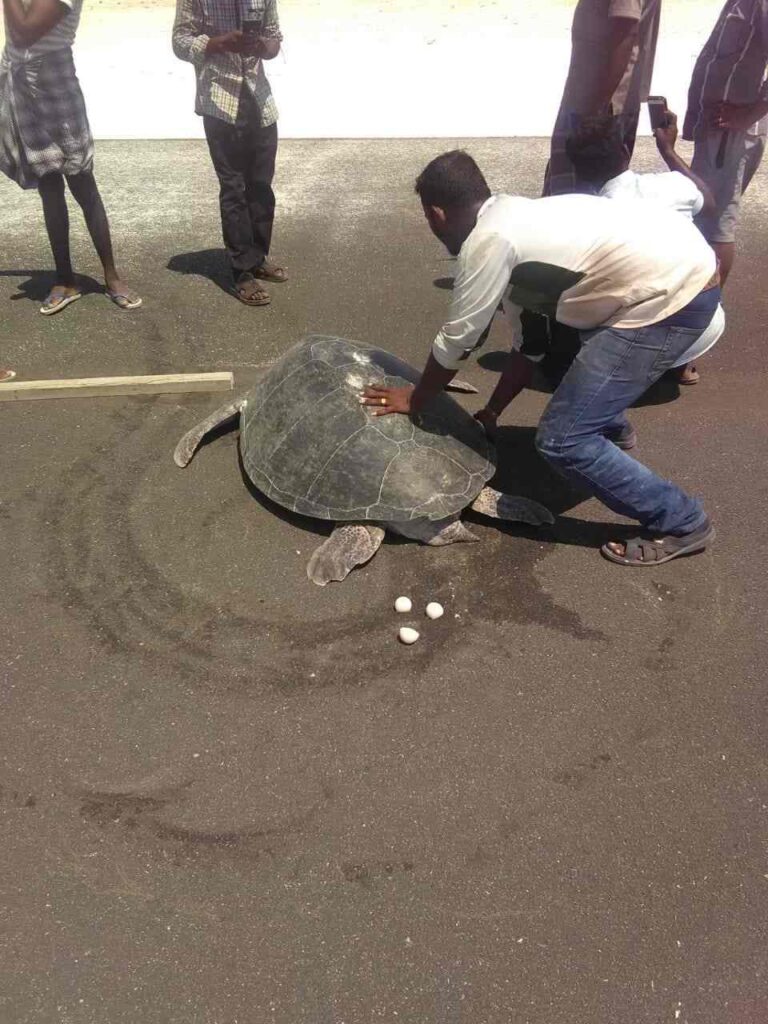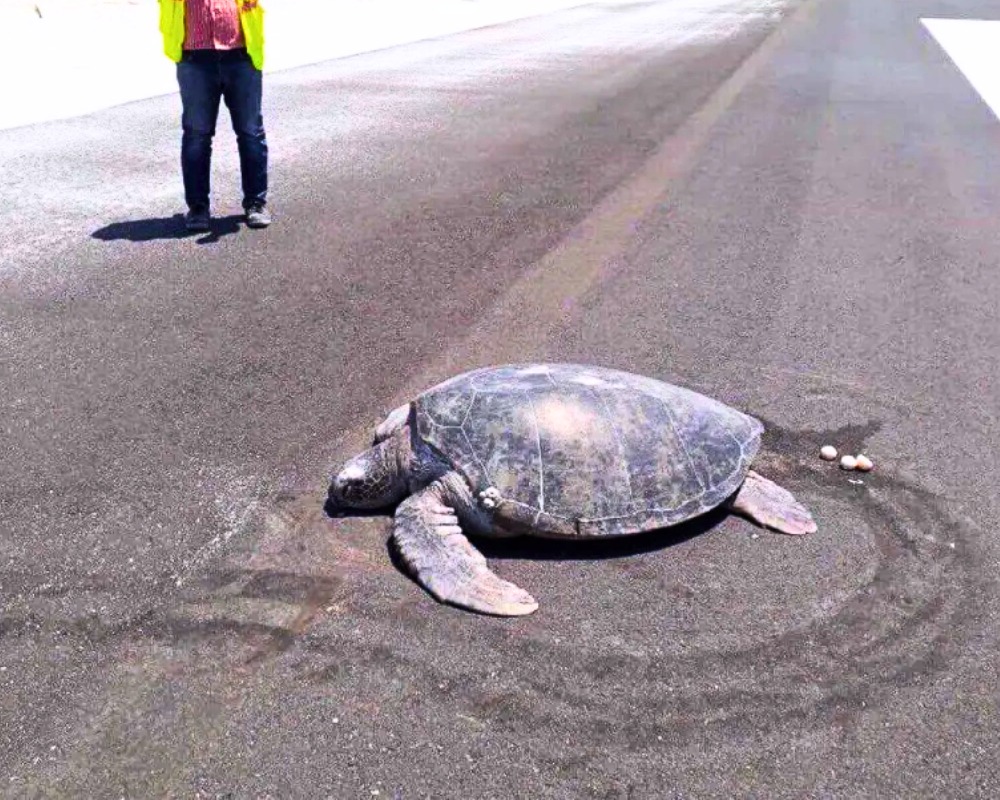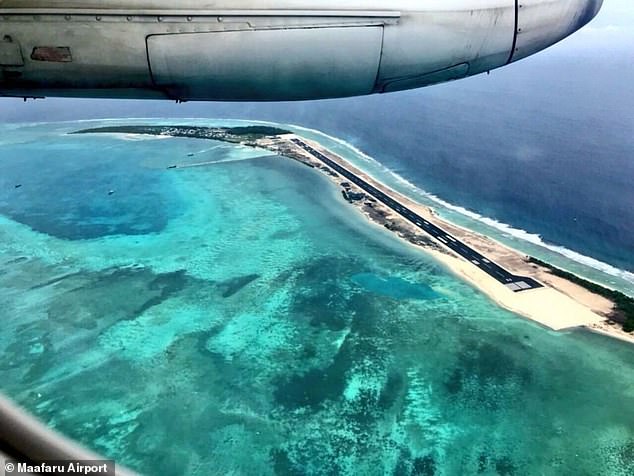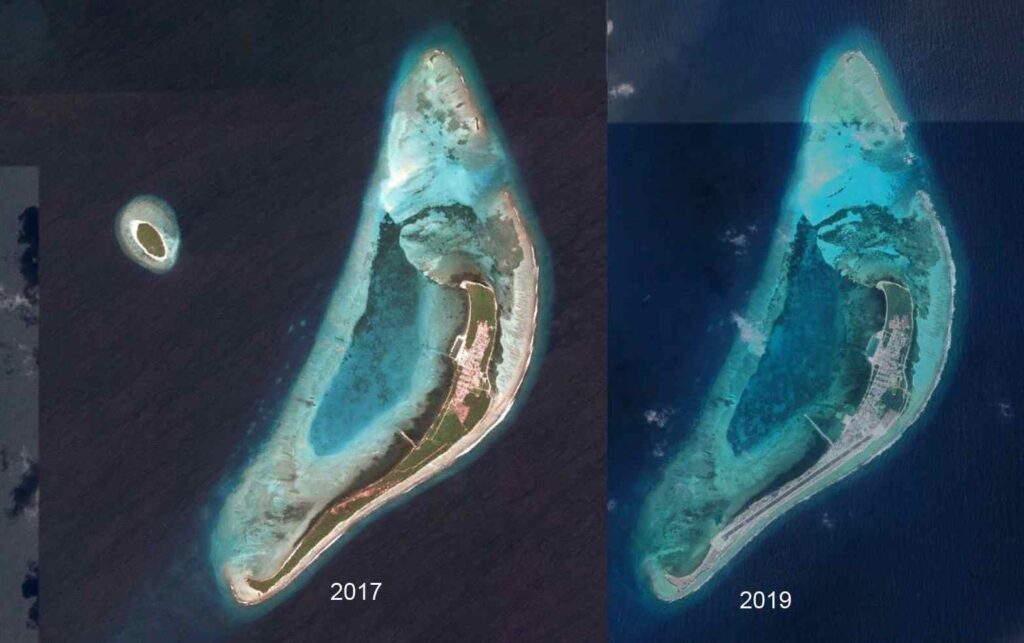A heart-wrenching image from the Maldives has reignited global debate about the environmental toll of rapid development. A green sea turtle, an endangered species, returned to her birth beach on Maafaru Island to lay her eggs — only to find a newly built runway where sand and sea once met.
The viral photo, showing the turtle beside three freshly laid eggs on the tarmac, has become a symbol of the growing tension between wildlife conservation and human expansion across the fragile ecosystems of the Indian Ocean.
The Lost Beach of Maafaru
For generations, Maafaru Island in the northern Noonu Atoll served as a critical nesting site for green sea turtles. These marine animals display remarkable instinct, returning to the very beach where they were born to reproduce — sometimes after traveling thousands of miles.
However, in 2018, the pristine coastline was replaced by a 2.2-kilometer-long airstrip, financed through a $60 million grant from the Abu Dhabi Fund as part of an infrastructure project under former President Abdulla Yameen’s administration. The entire island was stripped of its trees, and the once-thriving turtle habitat vanished under layers of concrete.
Despite the massive change, turtles like this one continued to come ashore, driven by instinct stronger than memory. Sadly, this return ended in tragedy.

The Viral Photo and Its Aftermath
When locals spotted the turtle laying eggs directly on the airport runway, they quickly captured photographs and shared them on social media. The image spread rapidly, sparking outrage and sorrow worldwide.
According to reports, island residents safely guided the turtle back to the ocean. But days later, the same turtle was found dead, her body discovered near the shoreline.
Veterinarian Dr. Claire Lomas, an expert in sea turtle rehabilitation, explained that the turtle may have been disoriented or stressed by the drastic environmental changes.
“It’s likely she was disturbed by the construction,” Lomas told Maldives Independent. “Turtles sometimes abort their eggs or become confused when their nesting grounds are destroyed. This case highlights the importance of preserving beaches critical to their survival.”

Mid-Article Read
Before continuing, explore this inspiring story:
Full Story: Man Loses 360 Pounds Naturally – Internet Rallies to Support His Next Step
Development vs. Nature
The Maafaru Airport project was originally rejected in 2009 after an environmental impact assessment (EIA) identified the island as a major turtle nesting ground. Despite that warning, the project was revived years later, and environmental approvals were fast-tracked.
Developers, backed by international funding, built the runway over the nesting area. Local authorities confirmed that turtles continued to attempt nesting even after construction finished — a haunting testament to nature’s persistence amid human disruption.
The Anti-Corruption Commission of the Maldives is now investigating alleged irregularities in the project’s bidding process, as well as unpaid payments to subcontractors. But for conservationists, the damage to nature has already been done.
“Human development nearly always impacts the environment,” Dr. Lomas added. “It’s crucial to take steps to minimize disturbance, especially in areas vital for species like sea turtles.”

The Bigger Picture: A Pattern Across Islands
The Maafaru tragedy is not isolated. Across the Maldives, several airport projects have encroached on ecologically sensitive zones. The government’s current plan includes new land reclamation on 17 islands and runway extensions across northern atolls.
One particularly controversial case involved the destruction of mangroves in Kulhudhuffushi, where an airport project dried up the natural lake, killing hundreds of fish and damaging the ecosystem. Despite promises of restoration, environmental groups warn that recovery could take decades.
Related Read
You might also like this story:
Full Story: The Hidden Meaning Behind Princess Diana’s Cannes Gown – A Heartfelt Farewell to Grace Kelly
The Turtle’s Silent Message
The image of the endangered turtle laying eggs on asphalt has become an unintentional message to humanity: progress without preservation is self-defeating. The Maldives, celebrated for its turquoise waters and coral reefs, depends on healthy ecosystems not just for biodiversity but for tourism — its primary economic engine.
Turtles were officially declared protected in the Maldives in 1994, and five species are known to inhabit the region’s waters. Yet, as climate change, coral bleaching, and coastal construction continue, their nesting sites grow fewer each year.
Local conservationists are calling for strict enforcement of environmental regulations and for designated “no-build” zones along remaining turtle nesting beaches.
Hope for the Future
While this story ends in tragedy, it has also sparked new public discussion about balancing development with wildlife protection. Environmental organizations in the Maldives are pushing for revised planning laws that require rigorous ecological reviews before any large-scale project begins.
Public awareness is growing, too — driven by the power of one viral photograph that captured both loss and resilience in a single frame.
Final Thoughts
The green sea turtle’s final journey on Maafaru Island is a cautionary tale about the cost of unchecked development. It underscores a truth often ignored: nature cannot adapt to human speed without consequence.
Preserving natural habitats is not just about saving animals — it’s about safeguarding the ecosystems that sustain all life, including our own. The turtle’s story is a silent plea for balance, reminding the world that progress must coexist with protection.


